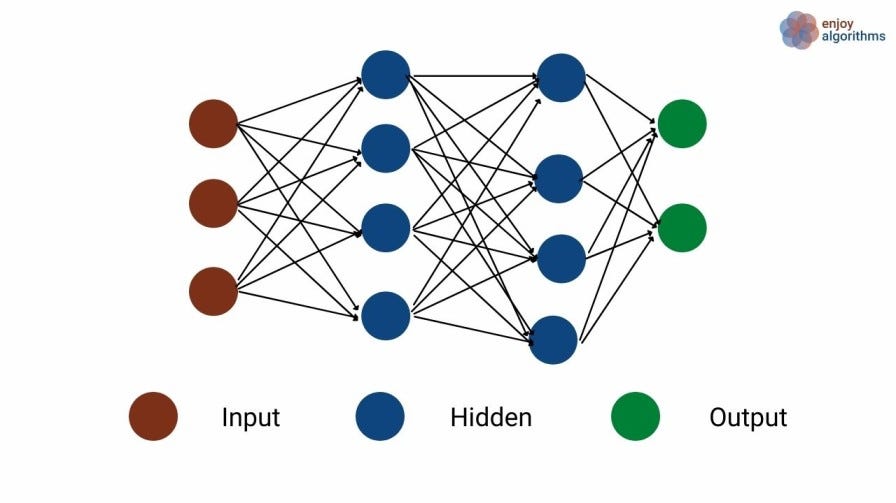Introduction to Machine Learning and Comparison With AI
In this article, we will explore the basic ideas that one should know about the most fascinating and emerging technology these days - Machine learning. After reading this article, we will be able to answer the fundamental questions like
1. What is Machine Learning?
2. Why do we need Machine Learning?
3. When did it start? What is the history of Machine Learning?
4. Where can we use Machine Learning?
So, let’s begin our journey towards knowing this beautiful technology and find the answer to four W’s (What, Why, When, and Where). Before proceeding any further, have you ever thought about how our brain works? Let’s start from here itself.
Indeed, the brain is the most complex part of our body; knowledge about its working principle is still big research underway. To explain the human body's most complex part, we can say that brain cells have perceptrons named Dendrites, which receive the electrical signals from the entire body and responds to those signals through the Axon terminals.

Whenever any known or similar set of inputs is received from dendrites, it gives a similar set of actions as outputs through axons. Saying more explicitly, it learns the mapping function from the input set to the output set.
Taking an analogy from the brain cells, if we try to represent brain cell functioning using bubbles, we can make a structure shown in the figure below. And you know what - this structure is called Neural Network of Machine Learning.

Now, let’s learn the definition of Machine Learning, which will help us to answer our first W, which is: What is Machine Learning?
- Machine learning is the science of getting computers to act without being explicitly programmed.
- Wikipedia definition: Machine Learning is a computer science field that gives computers the ability to learn without being explicitly programmed.
Did you notice something similar between these two definitions? To understand the similarity in a better way, Let’s first know what traditional programming is? In traditional programming, we basically write functions as our computer program, and whenever we pass some input to those functions, they produce corresponding outputs.

In machine learning, the computer takes Data and Output as its input parameters and tries to produce the best suitable function that maps Data to Outputs. Basically, the computer is learning a mapping function that maps the input data to the output data (Similar to the brain's functioning).

Now you must understand why both the famous definitions included the statement, without explicitly programming the computer, ML provides computers the ability to learn. We do not write computer programs; it automatically learns the program based on historical data.
Now, we know - what is machine learning? Shouldn’t we ask ourselves - why do we need machine learning?
We all know that computer programs are used for automation. And for this automation, Software Engineer is a very highly paid post in almost all software firms ranging from Google to newly formed small startups.
So if a computer program is automation, then Machine Learning is automating the process of automation. And that’s why we need machine learning. So we successfully found the answer to our second W (Why ML?).
A breakthrough in machine learning would be worth ten Microsofts.
— Bill Gates, Former Chairman, Microsoft
To know everything about anything, we must know how it actually started? So let’s continue our journey toward finding the answer to our third W, which is
When did it start? What is the History of Machine Learning?
In the 1950s, Arthur Samuel of IBM invented a program for the Game of Checkers. Based on the idea of rewards given (in terms of points) to the computers, they win the game or play a rational move. He came up with the name “Machine Learning” in 1952.  In 1957, Frank Rosenblatt developed the first successful neuro-computer with Mark 1 Perceptron's name, originally intended to be a custom-built hardware machine instead of a software program for Image recognition. Due to its resemblance to biological neurons, it created hype in public. People were so optimistic, and hence in 1958, NewYork Times published
In 1957, Frank Rosenblatt developed the first successful neuro-computer with Mark 1 Perceptron's name, originally intended to be a custom-built hardware machine instead of a software program for Image recognition. Due to its resemblance to biological neurons, it created hype in public. People were so optimistic, and hence in 1958, NewYork Times published
“the Navy [has] revealed the embryo of an electronic computer today that it expects will be able to walk, talk, see, write, reproduce itself and be conscious of its existence.”
Soon, people noticed the shortcomings of the idea when ML failed to learn the simple XOR function. They tried stacking many layers of mark-1 perceptron together (multilayer perceptron) to make the model stronger but eventually, it did not work.
Later in the 1970s or earlier 1980s, Machine Learning and Artificial Intelligence took separate paths. Today, many of us think that both of them (AI & ML) are the same. Picturing the Venn diagram of Artificial Intelligence and Machine Learning, we can clearly see that ML is just a subset of AI.

Let’s quickly know the definition of Artificial Intelligence so that we can correlate more easily.
Artificial intelligence (AI) refers to the simulation of human intelligence in machines programmed to think like humans and mimic their actions.
If any program senses the environment and takes hard-coded (based on human behavior) decisions, it’s Artificial Intelligence. For example, suppose an autonomous car is fitted with a LIDAR sensor that detects the vehicle's distance from obstacles. And there is an algorithm that applies brakes based on some function that takes the input of distance. There is no learning involved in this entire process. Hence this is not Machine Learning, but yes, this is Artificial Intelligence because it imitates human intelligence.

People started utilizing the known information about the input sets, which resulted in Artificial Intelligence's growth. At that time, multilayer perceptrons needed very high computational power, and because of this, the whole research of machine learning became idle. It gained popularity again in the 1990s when a million times faster computers came into existence. In 2012, after discovering AlexNet architecture ( A Neural Network Architecture named after its discoverer, Alex), it showed tremendous potential and never lost popularity henceforth.
At this stage of our journey, we have successfully answered the three Ws (What, Why, and When) of Machine learning. To wrap up quickly, let’s quickly find the answer to the fourth W, which is
Where can we use the technology of Machine Learning?
To give you some coolest examples where ML can play a vital role, let’s see some applications.
Famous Applications of Machine Learning
Robotics: Autonomous Bots, Self-driving cars et.
Finance: Evaluation of risk on credit offers, Decision to invest money.
E-commerce: Prediction of inventory stocks, Predicting and Suggesting similar products
Biology: Drug design based on experience.
ChatBots: Translators, Human voice recognition
Some mind-blowing facts related to machine learning.
- Google’s AlphGo, a machine learning-based program, beat 18-time world champion Lee Sedol in a chess game.
- Machine Learning algorithms can predict lung cancer in its earliest stage based on detailed images.
- A company used an ML algorithm for Code anonymization. They had 600 programmers, took 8 code samples from each, and the algorithm could predict who wrote the code with 83% accuracy. Imagine how useful this could be whenever there are any Ransomware attacks.
Conclusion
In this article, we have answered the four W’s of machine learning: What, Why, Where, and When. We talked about the difference between Machine Learning and Artificial Intelligence and the difference between ML algorithms and traditional programs. We saw some cool real-life applications of machine learning and artificial intelligence and some mind-blowing facts related to it.
Critical Questions to Explore
Question 1: Why did someone term it “Machine Learning”?
Question 2: How is ML different from Artificial Intelligence?
Question 3: What makes traditional programs different from ML algorithms?
Question 4: Why Mark-1 perception failed to learn XOR gate?
Question 5: How can ML algorithms help in cyber-security?
If you have any queries/doubts/feedback/other ideas, please comment below or write us at contact@enjoyalgorithms.com. Enjoy learning, Enjoy machine learning, Enjoy algorithms!
Share Your Insights
More from EnjoyAlgorithms
Self-paced Courses and Blogs
Coding Interview
OOP Concepts
Our Newsletter
Subscribe to get well designed content on data structure and algorithms, machine learning, system design, object orientd programming and math.
©2023 Code Algorithms Pvt. Ltd.
All rights reserved.
